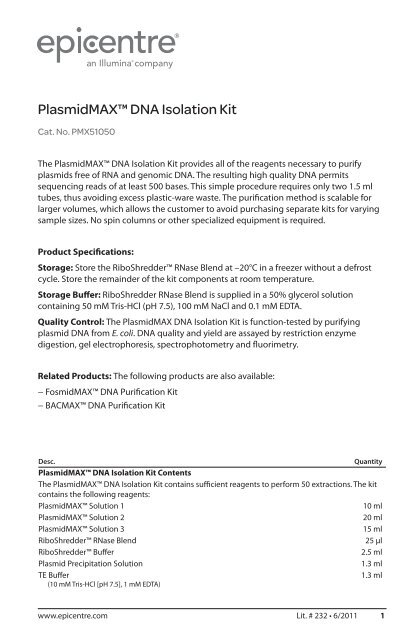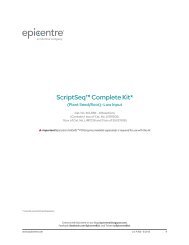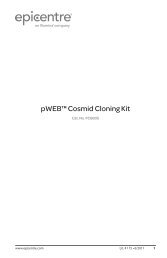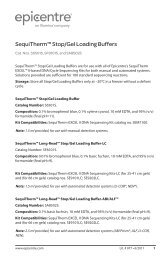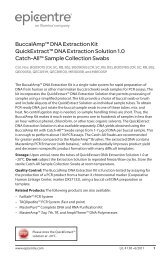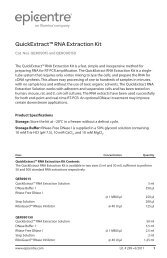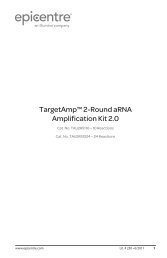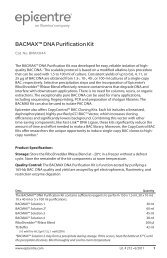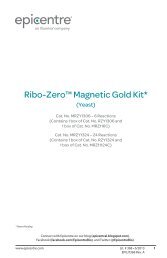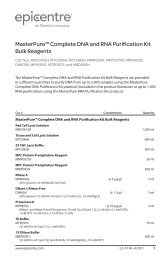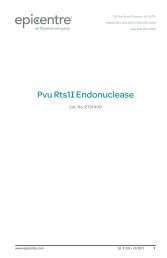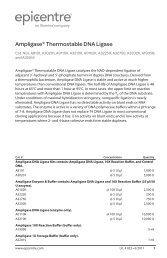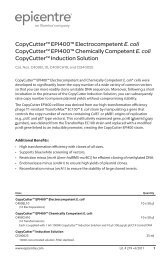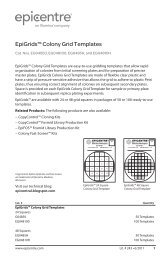Protocol for PlasmidMAX⢠DNA Isolation Kit
Protocol for PlasmidMAX⢠DNA Isolation Kit
Protocol for PlasmidMAX⢠DNA Isolation Kit
You also want an ePaper? Increase the reach of your titles
YUMPU automatically turns print PDFs into web optimized ePapers that Google loves.
PlasmidMAX <strong>DNA</strong> <strong>Isolation</strong> <strong>Kit</strong><br />
Cat. No. PMX51050<br />
The PlasmidMAX <strong>DNA</strong> <strong>Isolation</strong> <strong>Kit</strong> provides all of the reagents necessary to purify<br />
plasmids free of RNA and genomic <strong>DNA</strong>. The resulting high quality <strong>DNA</strong> permits<br />
sequencing reads of at least 500 bases. This simple procedure requires only two 1.5 ml<br />
tubes, thus avoiding excess plastic-ware waste. The purification method is scalable <strong>for</strong><br />
larger volumes, which allows the customer to avoid purchasing separate kits <strong>for</strong> varying<br />
sample sizes. No spin columns or other specialized equipment is required.<br />
Product Specifications:<br />
Storage: Store the RiboShredder RNase Blend at –20°C in a freezer without a defrost<br />
cycle. Store the remainder of the kit components at room temperature.<br />
Storage Buffer: RiboShredder RNase Blend is supplied in a 50% glycerol solution<br />
containing 50 mM Tris-HCl (pH 7.5), 100 mM NaCl and 0.1 mM EDTA.<br />
Quality Control: The PlasmidMAX <strong>DNA</strong> <strong>Isolation</strong> <strong>Kit</strong> is function-tested by purifying<br />
plasmid <strong>DNA</strong> from E. coli. <strong>DNA</strong> quality and yield are assayed by restriction enzyme<br />
digestion, gel electrophoresis, spectrophotometry and fluorimetry.<br />
Related Products: The following products are also available:<br />
− FosmidMAX <strong>DNA</strong> Purification <strong>Kit</strong><br />
− BACMAX <strong>DNA</strong> Purification <strong>Kit</strong><br />
Desc.<br />
Quantity<br />
PlasmidMAX <strong>DNA</strong> <strong>Isolation</strong> <strong>Kit</strong> Contents<br />
The PlasmidMAX <strong>DNA</strong> <strong>Isolation</strong> <strong>Kit</strong> contains sufficient reagents to per<strong>for</strong>m 50 extractions. The kit<br />
contains the following reagents:<br />
PlasmidMAX Solution 1<br />
10 ml<br />
PlasmidMAX Solution 2<br />
20 ml<br />
PlasmidMAX Solution 3<br />
15 ml<br />
RiboShredder RNase Blend<br />
25 μl<br />
RiboShredder Buffer<br />
2.5 ml<br />
Plasmid Precipitation Solution<br />
1.3 ml<br />
TE Buffer<br />
1.3 ml<br />
(10 mM Tris-HCl [pH 7.5], 1 mM EDTA)<br />
www.epicentre.com Lit. # 232 • 6/2011 1
PlasmidMAX <strong>DNA</strong> <strong>Isolation</strong> <strong>Kit</strong><br />
Plasmid <strong>DNA</strong> Purification <strong>Protocol</strong><br />
1. Pellet 1-1.5 ml aliquots of late log or stationary phase E. coli cultures <strong>for</strong> 1 minute in a<br />
microcentrifuge at maximum speed.<br />
2. Remove the supernatant with a pipet tip.<br />
3. Thoroughly resuspend the bacterial pellet in 200 μl of PlasmidMAX Solution 1 by<br />
pipetting the mixture up and down.<br />
4. Add 400 μl of PlasmidMAX Solution 2<br />
Note: If Solution 2 has precipitated, warm briefly at 37°C to redissolve.)<br />
Mix the contents by inverting the tube 4-6 times until the cell suspension “clears”.<br />
5. Add 300 μl of PlasmidMAX Solution 3. Mix the contents by inverting the tube 4-6<br />
times. A white precipitate consisting of cellular debris and chromosomal <strong>DNA</strong> will<br />
appear.<br />
6. Pellet cellular debris by spinning in a microcentrifuge at maximum speed <strong>for</strong> 10<br />
minutes at 4°C. Transfer the supernatant solution to a clean tube. Be careful not to<br />
take any white precipitate to the next tube.<br />
7. Add 550 μl of 100% isopropanol. Mix the contents by inverting the tube and spin the<br />
tube in a microcentrifuge at maximum speed <strong>for</strong> 10 minutes.<br />
8. Completely remove the isopropanol with a pipet tip.<br />
Respin the tube <strong>for</strong> 10 seconds and further remove any residual isopropanol.<br />
9. Add 1 μl of RiboShredder RNase Blend to 100 μl of RiboShredder Buffer.<br />
Mix and add 50 μl of this solution to each <strong>DNA</strong> pellet (100 μl is enough <strong>for</strong> 2 pellets.).<br />
Mix thoroughly by vortexing.<br />
10. Incubate at 37°C <strong>for</strong> 15 minutes.<br />
11. Add 25 μl of Plasmid Precipitation Solution.<br />
12. If the plasmid is >10-15 kb, invert the tube 4-6 times. Otherwise, briefly vortex and<br />
then let the sample sit at room temperature <strong>for</strong> 10 minutes.<br />
13. Pellet the plasmid <strong>DNA</strong> in a microcentrifuge at maximum speed <strong>for</strong> 10 minutes at<br />
room temperature or 4°C.<br />
14. Carefully remove the supernatant solution. Rinse the pellet with 200 μl of 70%<br />
ethanol being careful not to lose the plasmid <strong>DNA</strong>.<br />
15. Spin in a microcentrifuge at maximum speed <strong>for</strong> 10 minutes at room temperature or<br />
4°C. Carefully remove the supernatant fluid.<br />
16. Resuspend the pellet (which may be invisible) in 25 μl of TE Buffer.<br />
17. Measure the <strong>DNA</strong> concentration with fluorimetry and Hoechst Dye 33258 or by<br />
absorbance at 260 nm.<br />
BACMAX, FosmidMAX, PlasmidMAX, and RiboShredder are trademarks of Epicentre, Madison, Wisconsin.<br />
Visit our technical blog: epicentral.blogspot.com<br />
2 www.epicentre.com
Notes<br />
techhelp@epicentre.com • (800) 284-8474 3
726 Post Road, Madison, WI 53713 (800) 284-8474 (608) 258-3080 Fax (608) 258-3088<br />
4 www.epicentre.com


